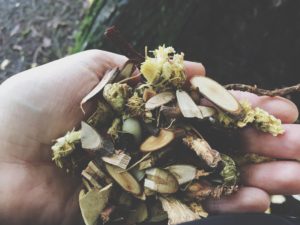In the first two articles of this series, I discussed my reasons for transitioning to herbs-only practice and began to discuss the process I’m undergoing to make it a reality. You can read the first part here, and the second part here.
Now, I’d like to talk about building an appropriate container for herbs-only practice.
I have always done herbs-only appointments as an alternative to treatment with acupuncture. I’d say that, over the life of my practice, maybe 10-20% of my overall visits have been herbs-only. My experience of doing that work has always been frustrating. In contemplating the transition to solely Chinese herbal practice, I understood the source of my frustration.
How I have set up my appointment structure, and indeed my approach to treatment, is oriented around the use of acupuncture. In removing the acupuncture without restructuring the way I do treatment and conduct an appointment, I was weakening my treatments overall. Herbs-only treatment isn’t just a stripped down form of an acupuncture treatment. It is something else entirely. It requires its own container.
 When I use the word “container,” I am referring to all of those aspects of my business and practice that allow treatment to take place. Treatment requires 3 things on this view: a practitioner, a patient, and the container in which they come together to effect a change in the patient’s experience. That container is the reason your business exists, and nothing is more important in developing a successful acupuncture practice.
When I use the word “container,” I am referring to all of those aspects of my business and practice that allow treatment to take place. Treatment requires 3 things on this view: a practitioner, a patient, and the container in which they come together to effect a change in the patient’s experience. That container is the reason your business exists, and nothing is more important in developing a successful acupuncture practice.
The container of my acupuncture appointments depended upon the acupuncture. The acupuncture itself was doing work, of course, and that work has to be replaced or accounted for or my success will vary. But, more importantly, the acupuncture time itself gave me time to think about treatment, gave the patient time to ask questions and think about their situation, and gave me the time to compound their herbal formula.
So, I set about creating a new container. One that would support herbs-only practice and take advantage of what I’ve learned so far. I’ll find time to lay that out in more detail in the future.
To satisfy your curiosity, I’ll note that my herbs-only appointments will now involve:
- Multiple appointment lengths possible to allow for more frequent pulse readings early on in treatment
- A robust email newsletter and online database of information to help patients learn more about themselves, their world, and their treatment
- Very regular check-ins automated using digital technologies so that we can respond to changes in patient experience as the formula begins to work (or not)
- More diagnostics (chiefly including abdominal and channel palpation) to make up for the smaller amount of time I spend with the patients due to shorter appointment times
- A stronger focus on helping patients with lifestyle factors, especially how everyday behavior can strengthen or weaken the efficacy of treatment
All of this work on the container is primarily to help treatment be more effective and is motivated by my deep desire to help patients. But it’s also great for the business of my practice! As I’m working out these logistical factors, I’m learning about how to talk about this new mode of practice. This will immediately feed into my marketing efforts and help patients become aware of and comfortable with herbs-only practice.
Relevant and creative marketing is the key in my transition to herbs-only practice
Ultimately, all of my concerns about the financial viability of this mode of practice come down to marketing. I have a broad understanding of marketing that includes all the things we do as acupuncture practitioners to help patients decide to work with us. And, of course, the things we do to keep them as lifelong patients who come to you with all of their relevant concerns. In other words, marketing is not just our Instagram posts or our local newspaper ads.
As discussed, my efforts to define and support this new herbs-only practice directly inform my marketing. Before you can encourage someone to jump on board with something, you need to define adequately what that thing encompasses. This is an intensely creative process for me, involving word-craft but also searching for photos and other images that illustrate concepts well. I’ve even launched into hand drawing some materials with my iPad Pro and Apple Pencil.
I am creating an entirely new section of our website that helps potential patients to understand what herbs-only practice involves and how it can benefit them. This content will then be repurposed in social media messages, email newsletters and flyers, as well as part of it being further developed into handouts and other information for use by people who are already patients. The information that is on the website will, of course, add to our Search Engine Optimization (SEO) efforts to promote the clinic more generally.
There is obviously a lot to unpack regarding the marketing. But for now it seems sufficient to say that much of my time invested in this project so far has been about thinking through and creating content to share with others. As I polish content pieces, I’ll share them with you here or on social media.
In the next article, I’ll explore one of the most important benefits of my practice transition : the power of focus.
In the meantime, I encourage you to ask questions or otherwise interact with me on Twitter and Instagram.The latter is free to join, and the registration link is on the main page. If you run into issues with signing up, reach out.

[…] tight spots in our lives, we’ve learned a huge amount about ourselves and our community. I made the decision to convert to herbs only practice during our shutdown period, and in the aftermath, I’ve relaunched Deepest Health and written a series of courses that […]